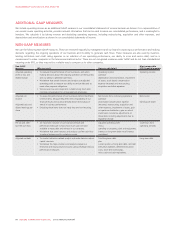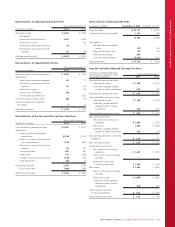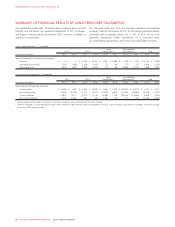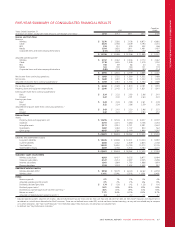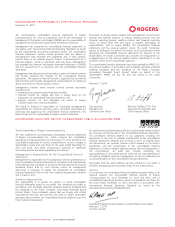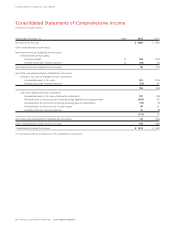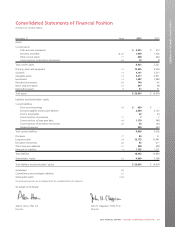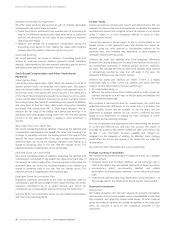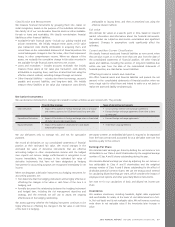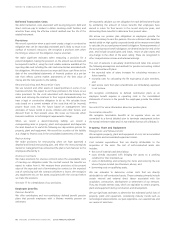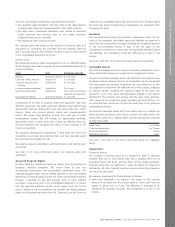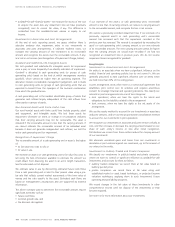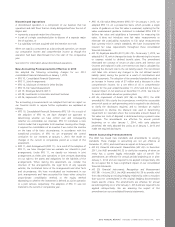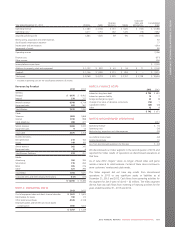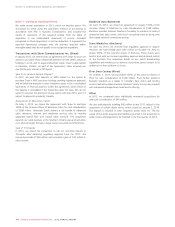Rogers 2013 Annual Report Download - page 98
Download and view the complete annual report
Please find page 98 of the 2013 Rogers annual report below. You can navigate through the pages in the report by either clicking on the pages listed below, or by using the keyword search tool below to find specific information within the annual report.
NOTES TO CONSOLIDATED FINANCIAL STATEMENTS
Notes to Consolidated Financial Statements
We,us,our,Rogers,Rogers Communications and the Company refer to
Rogers Communications Inc. and our subsidiaries. RCI refers to the legal
entity Rogers Communications Inc., not including our subsidiaries. RCI
also holds interests in various investments and ventures.
NOTE 1: NATURE OF THE BUSINESS
Rogers Communications is a diversified Canadian communications and
media group. Substantially all of our operations and sales are in
Canada. RCI is incorporated in Canada and its registered office is
located at 333 Bloor Street East, Toronto, Ontario, M4W 1G9. RCI’s
shares are publicly traded on the Toronto Stock Exchange (TSX: RCI.A
and RCI.B) and on the New York Stock Exchange (NYSE: RCI).
We report our results of operations in four segments:
Wireless Wireless telecommunications operations for
consumers and businesses
Cable Cable telecommunications operations,
including cable television, Internet and
cable telephony for Canadian consumers
and businesses
Business Solutions Network connectivity through our fibre
network assets to support a range of voice,
data, networking, data centre and cloud-
based services for medium and large
Canadian businesses, governments, and
other telecommunications providers
Media A diversified portfolio of media properties,
including television and radio broadcasting,
digital media, multi-platform shopping,
publishing and sports media and
entertainment
Wireless, Cable and Business Solutions are operated by our subsidiary,
Rogers Communications Partnership, and our other wholly owned
subsidiaries. Media is operated by our wholly owned subsidiary Rogers
Media Inc. and its subsidiaries.
See note 3 for more information about our operating segments.
Statement of Compliance
We prepared our consolidated financial statements according to
International Financial Reporting Standards (IFRS) as issued by the
International Accounting Standards Board (IASB). Our Board of
Directors approved the consolidated financial statements for the years
ended December 31, 2013 and 2012 on February 12, 2014.
NOTE 2: SIGNIFICANT ACCOUNTING POLICIES
Basis of Presentation
All amounts, except per share amounts, are in Canadian dollars, which
is our functional currency, and rounded to the nearest million, unless
otherwise noted. We prepare the consolidated financial statements on a
historical cost basis, except for certain financial instruments, liabilities
for cash-settled share-based payments and the net deferred pension
liability, which we measure at fair value as described in the notes.
Basis of Consolidation
Subsidiaries
Subsidiaries are entities we control. We include the financial statements
of our subsidiaries in our consolidated financial statements from the
date we gain control of them until our control ceases. We eliminate all
intercompany transactions and balances on consolidation.
Business Combinations
We account for acquisitions of subsidiaries using the acquisition
method of accounting. We calculate the fair value of the consideration
paid as the fair value at the acquisition date of the following:
• assets given, plus
• equity instruments issued, less
• liabilities incurred or assumed at the date of exchange.
We measure goodwill as the fair value of the consideration transferred,
less the net recognized amount of the identifiable assets acquired and
liabilities assumed, all measured at fair value as of the acquisition date.
When the excess is negative, a bargain purchase gain is recognized
immediately in profit or loss.
We use estimates and judgment to determine the fair value of assets
acquired and liabilities assumed, using the best available information
including information from financial markets. This may include
discounted cash flow analyses which utilize key assumptions such as
discount rates, attrition rates, and terminal growth rates to estimate
future earnings. We expense the transaction costs associated with the
acquisitions as we incur them.
See note 7 for information related to business combinations in 2013
and 2012.
Use of Estimates and Judgments
When preparing our financial statements, management makes
judgments, estimates and assumptions that affect how accounting
policies are applied and the amounts we report as assets, liabilities,
revenue and expenses. Significant changes in the assumptions,
including those related to our future business plans and cash flows,
could materially change the carrying amounts we record. Actual results
could be different from these estimates.
We use estimates that are inherently uncertain in the following key
areas:
• considering inputs to determine the fair value of assets acquired and
liabilities assumed in business combinations (see Basis of
Consolidation, above)
• considering industry trends and other factors to determine the
estimated useful lives of property, plant and equipment (see Property,
Plant and Equipment, below)
• capitalizing direct labour, overhead and interest costs to property,
plant and equipment (see Property, Plant and Equipment, below)
• determining the recoverable amount of non-financial assets when
testing for impairment (see Impairment, below), and
• measuring the fair value of derivative instruments (see note 20),
pension obligations (see note 22) and stock-based compensation
liabilities (see note 24).
94 ROGERS COMMUNICATIONS INC. 2013 ANNUAL REPORT


